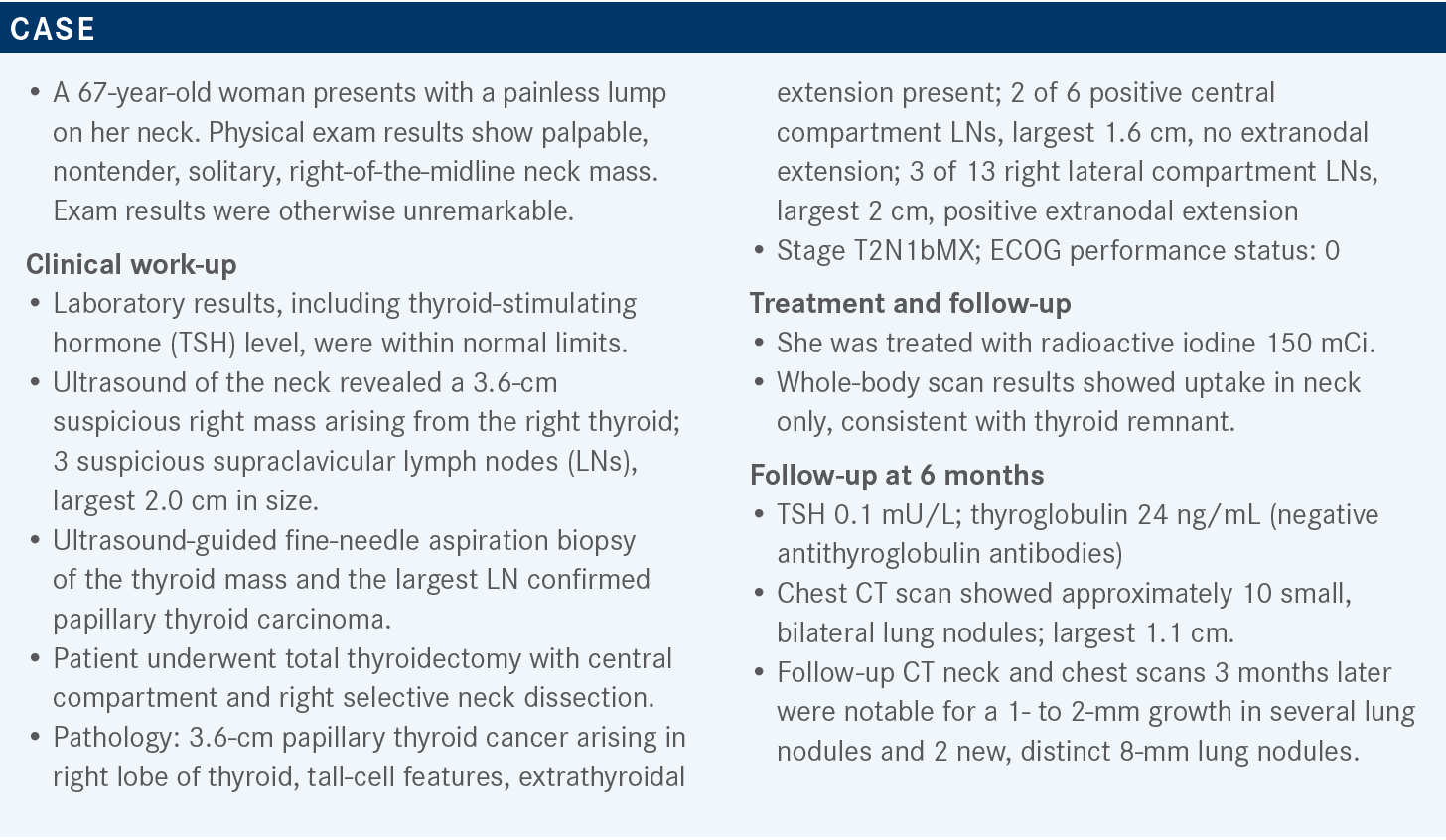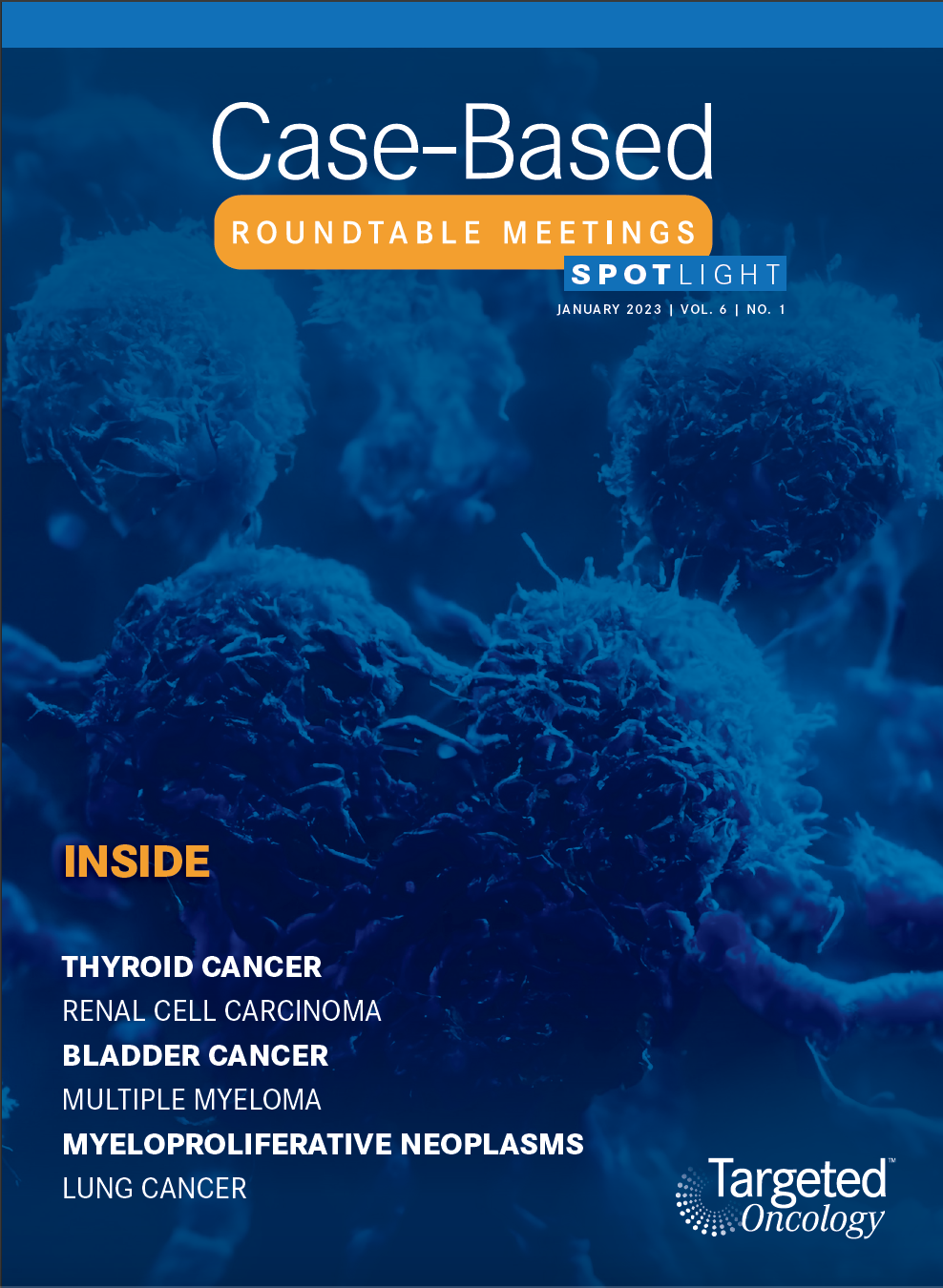Brose and Laetsch Discuss Rare Actionable Targets in Patients With Thyroid Cancer
During a Targeted Oncology case-based roundtable event, Marcia S. Brose, MD, PhD, and Theodore W. Laetsch, MD, discussed the data supporting the use of NTRK inhibitors in a patient with metastatic papillary thyroid cancer.

Marcia S. Brose, MD, PhD
Chief of Cancer Services
Sidney Kimmel Cancer Center
Jefferson Health Northeast
Philadelphia, PA

Theodore W. Laetsch, MD
Attending Physician
Developmental Therapeutics Program and Very Rare Malignant Tumors Program
The Children’s Hospital of Philadelphia
Philadelphia, PA

Targeted OncologyTM: Can you go over the treatment guidelines for patients with locally recurrent or metastatic papillary thyroid carcinoma?
BROSE: Lenvatinib [Lenvima] is preferred over sorafenib [Nexavar] in the NCCN [National Comprehensive Cancer Network] guidelines for patients with progressive or symptomatic disease, but larotrectinib [Vitrakvi] or entrectinib [Rozlytrek] are preferred for NTRK fusion– positive disease, and selpercatinib [Retevmo] or pralsetinib [Gavreto] are preferred for RET fusion–positive disease or medullary thyroid cancer.1
Pembrolizumab [Keytruda] has a pantumor indication, but interestingly, in thyroid cancer, it has been a disappointment. Maybe the reason for that is the other kinase inhibitors have been so good. What pembrolizumab added, in combination with a kinase inhibitor, is low; it’s good at adding toxicity and not so good at adding any additional efficacy. I don’t treat [patients] with pembrolizumab up front. I only give that to them after they’ve exhausted a TRK fusion inhibitor, and if that’s stopped, lenvatinib, sorafenib, or maybe even a clinical trial with a second-generation TRK inhibitor. I don’t expect a lot from pembrolizumab. I was in some of the original trials with that, and it was quite disappointing, as it didn’t seem like it added much.
That’s something that we can do either before we start treatment or if they’re responding well to treatment, [but] there’s one spot that stops responding to [management]. You can [manage] that rogue spot as another way of extending the clinical benefit of any of the agents you’re currently using. I tend to do that, and we have data from the DECISION study [NCT00984282] and the lenvatinib study [NCT02702388], so you can, in a way, double the progression-free survival [PFS] period by doing that.2,3
Can you discuss evidence for larotrectinib in NTRK fusion–positive cancer?
BROSE: Larotrectinib was approved based on 3 trials that were [pooled] together to get FDA approval. There is a phase 1 [trial] in adults, a pediatric phase 1/2 [trial], and an adult/adolescent basket trial. Together, there were a total of 244 patients with nonprimary CNS [central nervous system] NTRK fusion[–positive] cancer.
Adult patients were given larotrectinib 100 mg twice daily, and pediatric patients were given 100 mg/m2 twice daily, with a maximum of 100 mg twice daily. Overall response rate [ORR] was the primary end point, and the [secondary end points] were expected PFS, overall survival, and duration of response.
There were 25 different tumor types that had these fusions, but the majority were soft tissue sarcomas, infantile fibrosarcomas, or thyroid cancer that was in 12% of patients [in] the study.4 There were 87 pediatric patients and 157 adults, and most of the patients had good ECOG performance status, but there were several patients who had an ECOG performance status of 2 or 3. Many of these patients had been heavily pretreated, so that was a big thing. The majority [had] either NTRK1 or NTRK3 fusions, and the pediatric set [had] 94 total fusions.5
The square box is the integrated subset of 244 patients.4 The ORR was 69% [95% CI, 63%-75%]. There was a significant number, 51 patients, who had complete responses [CRs; 21%], and pathological CR [pCR] in some of the sarcomas where [researchers] went ahead and the tumor shrunk, so they did surgery in 13 patients.
Most patients had either a partial response or a CR, which is remarkable. Using sorafenib or lenvatinib, we never saw that many patients get a CR. One time we thought we had [CRs by using] lenvatinib, but they probably just [had] lymph nodes that got small enough to not count as pathologic anymore, and we know they still had tumors. So this CR was something we had not seen before.
The majority, all but 1 or 2 patients, had responses to the therapy.6,7 The response rate in papillary [thyroid cancer] was 86% [95% CI, 64%-97%]. Remember I had said we’re in the 60s. I think it was 63% for lenvatinib, and sorafenib was even lower. This compares well. Of course, it’s a different population so we can’t compare them completely, but 86% is certainly a nice, healthy response rate. Many [responses] were long-lived, with a 24-month duration of response at 81%, and these were rapid responses occurring usually by the first scan, at 2 months.
Of all the adverse events [AEs] related to larotrectinib, what’s remarkable is the majority were all grade 1 or 2. Larotrectinib was well tolerated, with only a couple of grade 3 and grade 4 [AEs], and many of them were [from] lab values, so the patients didn’t even notice them.4
With liver function tests [LFTs], the AST [aspartate transaminase] and the ALT [alanine transaminase] levels, if you hold [treatment] and the levels go down, then you can restart it and patients do great. Of these grade 3 and grade 4 [AEs], weight increase was one of the biggest ones. There were a couple of patients with a decreased neutrophil count. Remember, some of these patients had radioactive iodine, so that probably contributed to the fact that their bone marrow might have been a little sensitive. But [larotrectinib was] incredibly well tolerated, compared [with] what lenvatinib would have been.
What does the pediatric subset in the larotrectinib studies show?
LAETSCH: We saw remarkable results with larotrectinib in this patient population as well.5 These are 93 patients who were included in that prior combined analysis, most of whom had soft tissue sarcomas or infantile fibrosarcoma, but 2 of whom had papillary thyroid cancer. Across this cohort of patients, the ORR in pediatric patients was 84% [95% CI, 75%-91%], with over one-third of patients having a CR: either a CR radiographically or a pCR. Again, high response rate in this population. It was also rapid and durable, with a median duration of response of 43 months, a median overall response that hasn’t been reached, [and a] greater than 90% overall survival [rate] at the final time point on the Kaplan-Meier curve.
Similarly, the AEs with larotrectinib were mild in this patient population, mostly grade 1 and 2.5 The thing we saw the most [for] grade 3 and 4 [AEs] was neutropenia, often occurring in some of the younger children who were treated in this patient population.
The median age of these patients is about 2 years, so these are young children with few treatment-related drug discontinuations. In terms of neurologic effects of the normal role of the TRK receptors, neurologic treatment-related AEs were also quite rare, of which the most common was headache [in 12% of patients]. We didn’t see obvious evidence of developmental issues with this class of agents, although we’re still studying longer-term outcomes.
Please discuss the data for entrectinib in NTRK fusion–positive cancers.
LAETSCH: Just like larotrectinib, entrectinib was approved based on a combined analysis of 3 clinical trials: 2 adult phase 1 trials, an adult phase 2 trial, [and] a pediatric study.8 [The most recent data set was], just presented at the ASCO [American Society of Clinical Oncology Annual Meeting] this year.9 It contains [data on] 235 patients with NTRK fusion-positive cancers who received entrectinib.
There were 150 efficacy-evaluable patients.9 This is the adult data set, so the median age was 58 years. This was a heavily pretreated patient population, although for 34%, this was their first line of systemic therapy. Of this patient population, about 20% had CNS metastases, the majority of whom had had prior radiotherapy [on] the brain. There were 16 patients in this cohort who had thyroid cancer.
As with larotrectinib, we saw histology-agnostic efficacy of this agent, with an ORR of 61% [95% CI, 53.1%-69.2%] either with or without brain metastases.10 The subset of patients [with] a CR is 16.7% in this data set, with a median duration of response of about 20 months [95% CI, 13.2-31.1]. There was a range of responses [from the patients with thyroid cancer and] a subset of patients who had profound responses. In the patients [with] thyroid cancer, the ORR was 62%, with durations of response ranging from 5 to 44 months.
In terms of safety, like larotrectinib, these agents are well tolerated. There were a couple of AEs that were unique to entrectinib vs larotrectinib, including dysgeusia and diarrhea, which may be due to the broader antikinase spectrum of this agent [and the fact that] some patients [saw their] creatinine [level] increase with this agent, which wasn’t seen as commonly with larotrectinib. But in this update, there were no new safety signals identified from the original analysis that led to FDA approval.
The STARTRK Next-Generation trial [NCT02650401], or STARTRK NG, was the pediatric study of entrectinib that [involved] 43 patients, with a median age of 7 years [and] a range of diagnoses not including thyroid cancer.11 Of the fusion-positive patients, most of these patients had NTRK gene fusions (34%), although patients with ROS1 and ALK fusions were also eligible. Patients with ALK mutations, which are common in pediatric neuroblastoma, were also eligible for this study.
Of the patients with NTRK fusions, the response rate in children was 60%, with one-third of patients having a CR to this therapy. [This shows] unprecedented efficacy for a targeted therapy in children with fusion-positive tumors.11 AEs were generally [similar to] those seen in adults [Table11].

The AE that was of special interest and eventually resulted in a label modification was fracture: 21% of patients experienced bone fractures, 13 events in 9 patients, including at least 1 patient with bilateral femur fractures, which is quite uncommon in pediatric oncology. So there is some concern that this agent may increase the risk of fractures in children.
Can you differentiate the mechanisms of action for larotrectinib and entrectinib?
BROSE: [The mechanism of action includes] the inhibition of TRKA, TRKB, and TRKC for larotrectinib vs TRKA, TRKB, TRKC, ROS1, ALK, JAK2, and TNK2 for entrectinib.12,13 So the JAK2 activity is part of why you get more neutropenia with entrectinib than you get with larotrectinib.
That’s probably another mechanism of additional toxicity. We have the skeletal fracture warnings in both. The CNS effects are probably part of why [patients] eat more, and there can be a little more dizziness. There are some increased LFTs that can happen with larotrectinib [because] they tend to be asymptomatic, [but] they do resolve.
Have you seen skeletal fractures happen in a time-dependent fashion?
BROSE: I saw it in 1 adult, and it happened early on. It was like a stress fracture, and we did analysis in the adults, and it turned out that the number of fractures we were seeing in the study were comparable to other [patients] who had metastatic disease; it wasn’t thought to be higher. [Dr Laetsch], do you want to talk about how you would manage skeletal fractures in kids? Or is it that a deal breaker for you, as far as which you choose?
LAETSCH: On the pediatric side, we looked at this with larotrectinib, and it’s been looked at with entrectinib. For larotrectinib, 7% of children who had the drug had a fracture, which was thought to be relatively [similar to] the baseline rate, although we don’t have good data on the baseline rate in children.13
They weren’t thought to be related to larotrectinib by the treating investigator. I think we haven’t done anything special. There are ongoing studies looking at bone health in children treated with larotrectinib to try to better delineate this. Entrectinib has pushed us to use larotrectinib in this patient population, because of this concern for an increased risk of skeletal fracture in these patients.
BROSE: There is a little problem sometimes with withdrawal pain, where [patients] will have achiness an hour or two before their next dose. Some of those patients have also benefited from [reducing] their dose, interestingly. So that’s something we must watch out for, and sometimes the patient can just take acetaminophen [Tylenol] and be treated through it.
REFERENCES
1. NCCN. Clinical Practice Guidelines in Oncology. Thyroid cancer, version 3.2021. Accessed September 1, 2021. https://bit.ly/3glleK5
2. Brose MS, Nutting CM, Jarzab B, et al. Sorafenib in radioactive iodine-refractory, locally advanced or metastatic differentiated thyroid cancer: a randomised, double-blind, phase 3 trial. Lancet. 2014;384(9940):319-328. doi:10.1016/ S0140-6736(14)60421-9
3. Brose MS, Panaseykin Y, Konda B, et al. A Randomized Study of Lenvatinib 18 mg vs 24 mg in Patients With Radioiodine-Refractory Differentiated Thyroid Cancer. J Clin Endocrinol Metab. 2022;107(3):776-787. doi:10.1210/clinem/dgab731
4. Drilon AE, Hong DS, van Tilburg CM, et al. Long-term efficacy and safety of larotrectinib in a pooled analysis of patients with tropomyosin receptor kinase (TRK) fusion cancer. J Clin Oncol. 2022;40(suppl 16):3100. doi:10.1200/ JCO.2022.40.16_suppl.3100
5. Mascarenhas L, van Tilburg CM, Doz F, et al. Efficacy and safety of larotrectinib in pediatric patients with tropomyosin receptor kinase (TRK) fusion-positive cancer: an expanded dataset. J Clin Oncol. 2022;40(suppl 16):10030. doi:10.1200/JCO.2022.40.16_suppl.10030
6. Waguespack SG, Drilon A, Lin JJ, et al. Efficacy and safety of larotrectinib in patients with TRK fusion-positive thyroid carcinoma. Eur J Endocrinol. 2022;186(6):631-643. doi:10.1530/eje-21-1259
7. Hong DS, DuBois SG, Kummar S, et al. Larotrectinib in patients with TRK fusion-positive solid tumours: a pooled analysis of three phase 1/2 clinical trials. Lancet Oncol. 2020;21(4):531-540. doi:10.1016/ S1470-2045(19)30856-3
8. Doebele RC, Drilon A, Paz-Ares L, et al. Entrectinib in patients with advanced or metastatic NTRK fusion-positive solid tumours: integrated analysis of three phase 1-2 trials. Lancet Oncol. 2020;21(2):271-282. doi: 10.1016/S1470-2045(19)30691-6
9. Krzakowski MJ, Lu S, Cousin S, et al. Updated analysis of the efficacy and safety of entrectinib in patients (pts) with locally advanced/metastatic NTRK fusion-positive (NTRK-fp) solid tumors. J Clin Oncol. 2022;40(suppl 16):3099. doi:10.1200/JCO.2022.40.16_suppl.3099
10. Demetri GD, De Braud F, Drilon A, et al. Updated integrated analysis of the efficacy and safety of entrectinib in patients with NTRK fusion-positive solid tumors. Clin Cancer Res. 2022;28(7):1302-1312. Published correction appears in Clin Cancer Res. 2022;28(10):2196.
11. Desai AV, Robinson GW, Gauvain K, et al. Entrectinib in children and young adults with solid or primary CNS tumors harboring NTRK, ROS1, or ALK aberrations (STARTRK-NG). Neuro Oncol. 2022;24(10):1776-1789. doi:10.1093/ neuonc/noac087
12. Vitrakvi. Prescribing information. Bayer; 2021. Accessed November 13, 2022. https://bit.ly/3EtnSFu
13. Rozlytrek. Prescribing information. Genentech; 2019. Accessed November 13, 2022. https://bit.ly/3gnYPvF

Leon-Ferre Explores Targeting of PIK3CA Alterations in ER+ Breast Cancer
July 24th 2024During a live Community Case Forum event in partnership with the Minnesota Society of Clinical Oncology, Roberto A. Leon-Ferre, MD, discussed drugs targeting PIK3CA alterations in patients with ER+ metastatic breast cancer.
Read More
Anticipating Novel Options for the RAI-Refractory DTC Armamentarium
May 15th 2023In season 4, episode 6 of Targeted Talks, Warren Swegal, MD, takes a multidisciplinary look at the RAI-refractory differentiated thyroid cancer treatment landscape, including the research behind 2 promising systemic therapy options.
Listen
Roundtable Roundup: Treatment for Metastatic pMMR Endometrial Cancer
July 23rd 2024In separate, live virtual events, Michael J. Birrer, MD, PhD, and Jubilee Brown, MD, surveyed participants on the treatment of a postmenopausal woman with stage IVA endometrial cancer after first-line chemotherapy.
Read More
George Explores Impact of Risk Status With Cabozantinib/Nivolumab in Advanced RCC
July 19th 2024During a Case-Based Roundtable® event, Daniel George, MD, discussed the results of the CheckMate 9ER trial across favorable, intermediate, and poor risk groups in patients with advanced renal cell carcinoma.
Read More
Depth of Response With Quadruplet Regimens Considered in Newly Diagnosed Multiple Myeloma
July 18th 2024During a Case-Based Roundtable® event, Timothy Schmidt, MD, and participants discussed treatment selection for a 54-year-old patient with transplant eligible R-ISS stage 2/R2-ISS stage 3 IgG-κ myeloma.
Read More
Rossetti Reviews Myelofibrosis Risk Stratification and Outcome Data for Pacritinib
July 17th 2024During a Case-Based Roundtable® event, James M. Rossetti, DO, discussed the role of risk scoring and stratification tools and treatment for a patient with declining hemoglobin and platelet counts due to primary myelofibrosis.
Read More